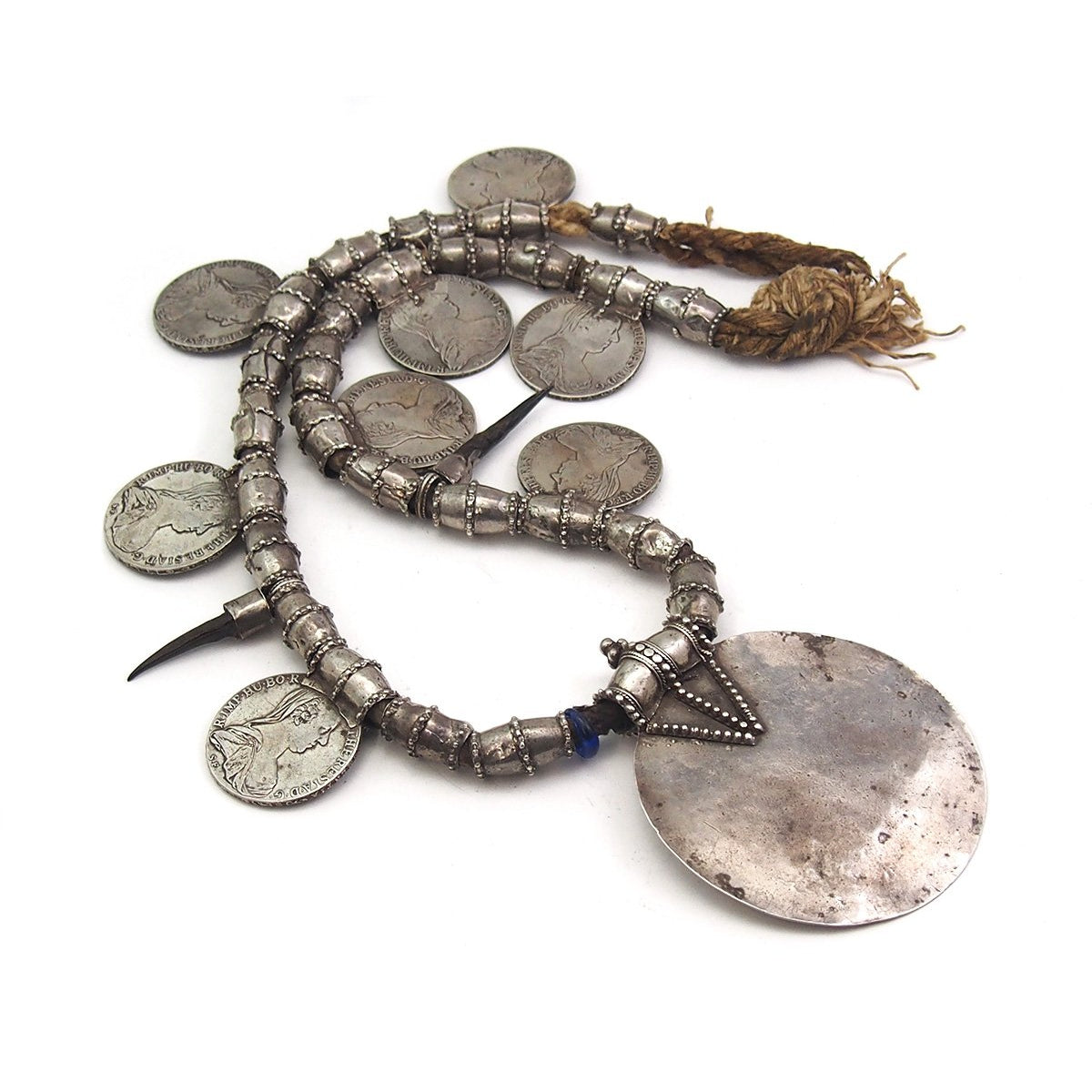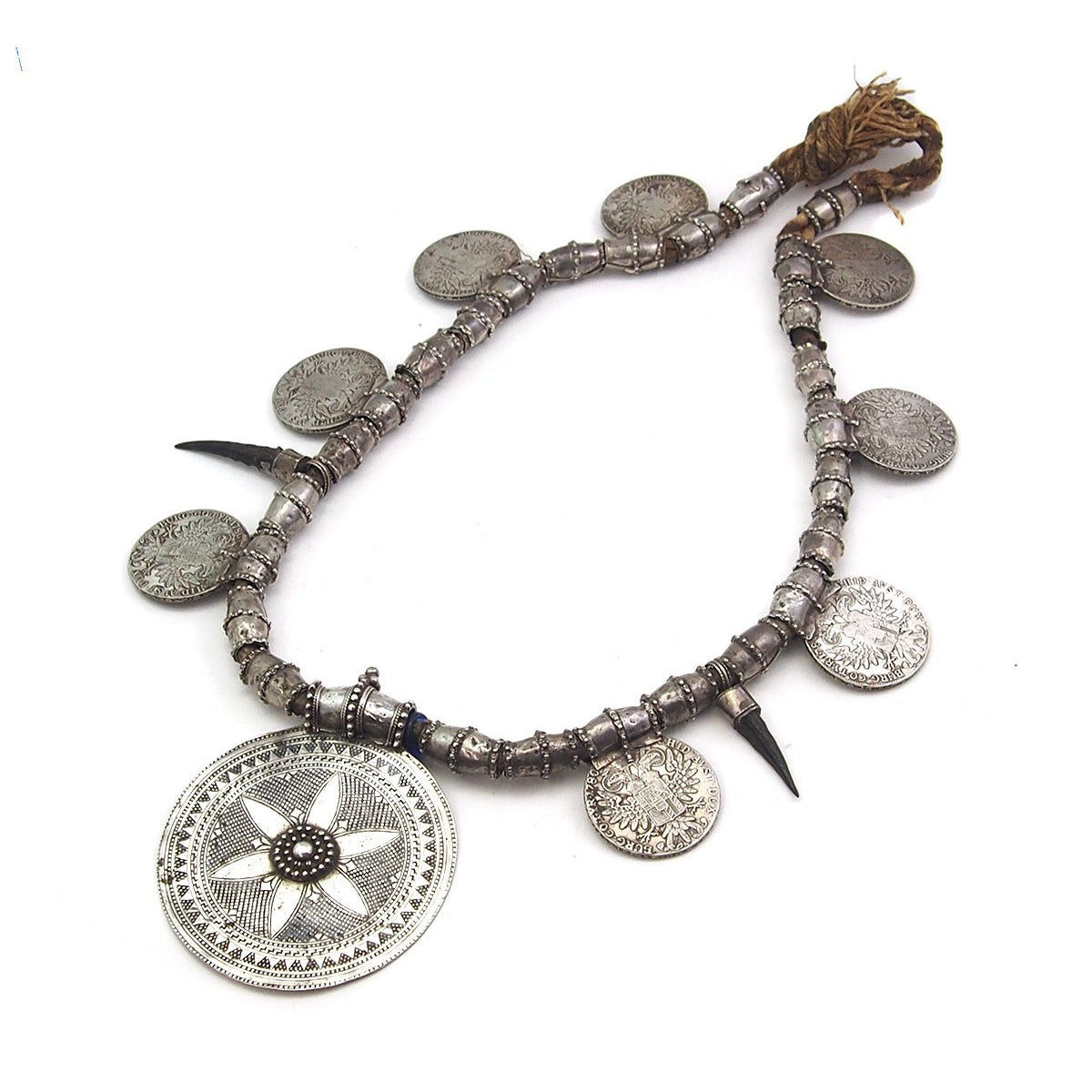Omani Somt Fine Silver Pectoral Necklace circa 1900-1950
- Omani Somt Fine Silver Pectoral Necklace circa 1900-1950
- Approx. 30″ long
- Bead size approx. Silver bead 14mm x 23mm, Coin 40mm, Centerpiece 87mm (3.43″)
- Material: Silver #92.5 Sterling Silver with authentic Maria Theresa Thalers.
- Omani Tribal Silver was still possible to find in the markets of Muscat, Nizwa, Ibri, Sur or Salalah or from still working silversmiths more remote mountain villages through the 1960’s-70’s. Sadly, that is no longer possible. True, authentic pieces are found only in private collections and/or museums throughout the world.
- Omani silver is prized amongst Tribal Jewelry Collectors for several reasons. Firstly, it is relatively rare. Oman has never had a large population and until the 1980’s the country was virtually closed off to foreign influence, trade and tourism.
- Secondly, the older pieces were made from very high quality silver obtained not in Oman (trace amounts available there only) but from the melting down of Maria Theresa Dollars, commonly referred to as Thalers. Maria Theresa Thalers have been struck in Austria since the reign of Empress Maria Theresa of the Austro-Hungarian Empire. The Empress died in 1780 and since that time, all Thalers that were subsequently struck were minted with that date regardless of the actual year that they were produced. The coins achieved such a level of trust for their silver content (which is 83.3% silver) in the Middle East that neither the design not the date was varied. For more than 200 years the coins were used as an international currency among the Tribes and the States of the Middle East-especially Oman, in much the same was as the Spanish dollar was used as an international currency at the time elsewhere. The Thalers were used to complete most important transactions locally and were also given as dowries. They were also an important source of silver and were melted locally for jewelry.
- Thirdly, Omani silversmiths, located in towns and hence not part of the Nomadic Tribal Culture they served were known for their high level of workmanship.
- Finally, because all Omani silver jewelry tended to be symbolic of the unity and special bonds within a family unit, it was rare that pieces were ever sold or passed down. When no longer used or the owner passed away, they would be melted down and re-fashioned in to new jewelry.
- ‘Somt’ is the widely used name for an Omani necklace which has a medallion as its centerpiece. The intricacy of the work on these medallions is said to be amongst the finest you will see on any piece of Bedouin Jewelry. The basic design is always the same and consists of a six petal flower and an awe inspiring pattern of concentric circles radiating outward.
- This Omani necklace, which would have represented a large portion of a bride’s dowry comprises a round silver sunburst disk decorated with niello work, eight silver Maria Theresa Thaler coins dated 1780 and twenty seven silver double barrel-shaped beads. Two acacia thorns inset into their own worked silver holders add to the interest and rarity of this necklace. Importantly, all elements have wear and patina demonstrating their age and the silver has the wonderful buttery feel of high grade old silver.
- The engraved medallions possibly represent “The Rayed Sun” frequently referred to in the Holy Koran.
- The Marriyah necklace (as it is referred to) would originally have been made for the owner to wear for her marriage ceremony and thereafter on special occasions.
- The engraved medallions possibly represent “The Rayed Sun” frequently referred to in the Holy Koran.
- The Marriyah necklace (as it is referred to) would originally have been made for the owner to wear for her marriage ceremonies and thereafter on special occasions.
- A similar example that is currently for sale in our shop is illustrated on page 98 in Lois Sherr Dubin’s magnificent book The History of Beads: From 30,000 B.C. to the Present (Abrams, 1987; reissued in paperback in 2004 and updated in 2009 as The History of Beads: From 100,000 to the Present), a beloved classic study and reference on the subject that has been published in five languages.

















